COVID-19 Forecast Models Report for Arizona, December 11 Update
Note this forecast page is not the most recent forecast available.
View the most current forecast report
Researcher Analyzes Arizona COVID-19 Spread Models for Decision-Makers
The following information regarding the spread of COVID-19 in Arizona was prepared by Joe Gerald, MD, PhD, a researcher at the Mel and Enid Zuckerman College of Public Health (MEZCOPH) at the University of Arizona. This information has also been reviewed by other MEZCOPH faculty.
This data were obtained from the Arizona Department of Health Services COVID-19 webpage and reflect conditions in Arizona as of December 11, 2020.
This information is intended to help guide our response to the outbreak. It is not intended to predict how this pandemic will evolve. Rather, this model extrapolates what might occur if current conditions remain unchanged. As regional authorities and healthcare providers respond, their actions are expected to mitigate the worst consequences of this pandemic.

COVID-19 Disease Outbreak Forecast
Arizona State and Pima County
Updated December 11, 2020
Disclaimer: This information represents my personal views and not those of The University of Arizona, the Zuckerman College of Public Health, or any other government entity. Any opinions, forecasts, or recommendations should be considered in conjunction with other corroborating and conflicting data. Updates can be accessed at https://publichealth.arizona.edu/news/2020/covid-19-forecast-model.
**NOTICE** Arizona is experiencing a public health crisis where access to critical care services is limited due to shortages of space, personnel, and critical supplies. If not addressed within the next 1 - 2 weeks, this crisis will evolve into a humanitarian crisis leading to hundreds of preventable deaths. At this point, only shelter-in-place restrictions are certain to quickly and sufficiently curtail viral transmission. Because such restrictions impose substantial economic hardships, these measures should be augmented by state expansion of programs to provide direct economic assistance, reduce food insecurity, prevent foreclosure and evictions, and protect access to health services.
For the week ending December 6th, at least 40356 new Covid-19 cases were diagnosed in Arizona (Figure 1). This is a 36% increase from last week’s initial tally of 29770 cases and a new state record. Last week’s tally was only upwardly revised by 229 cases this week, a 1% increase. While last week’s sharp decline in testing was an aberration, test positivity continues to increase reaching a new record this week, 25%. Limited access to testing during Thanksgiving meant that many cases were missed.
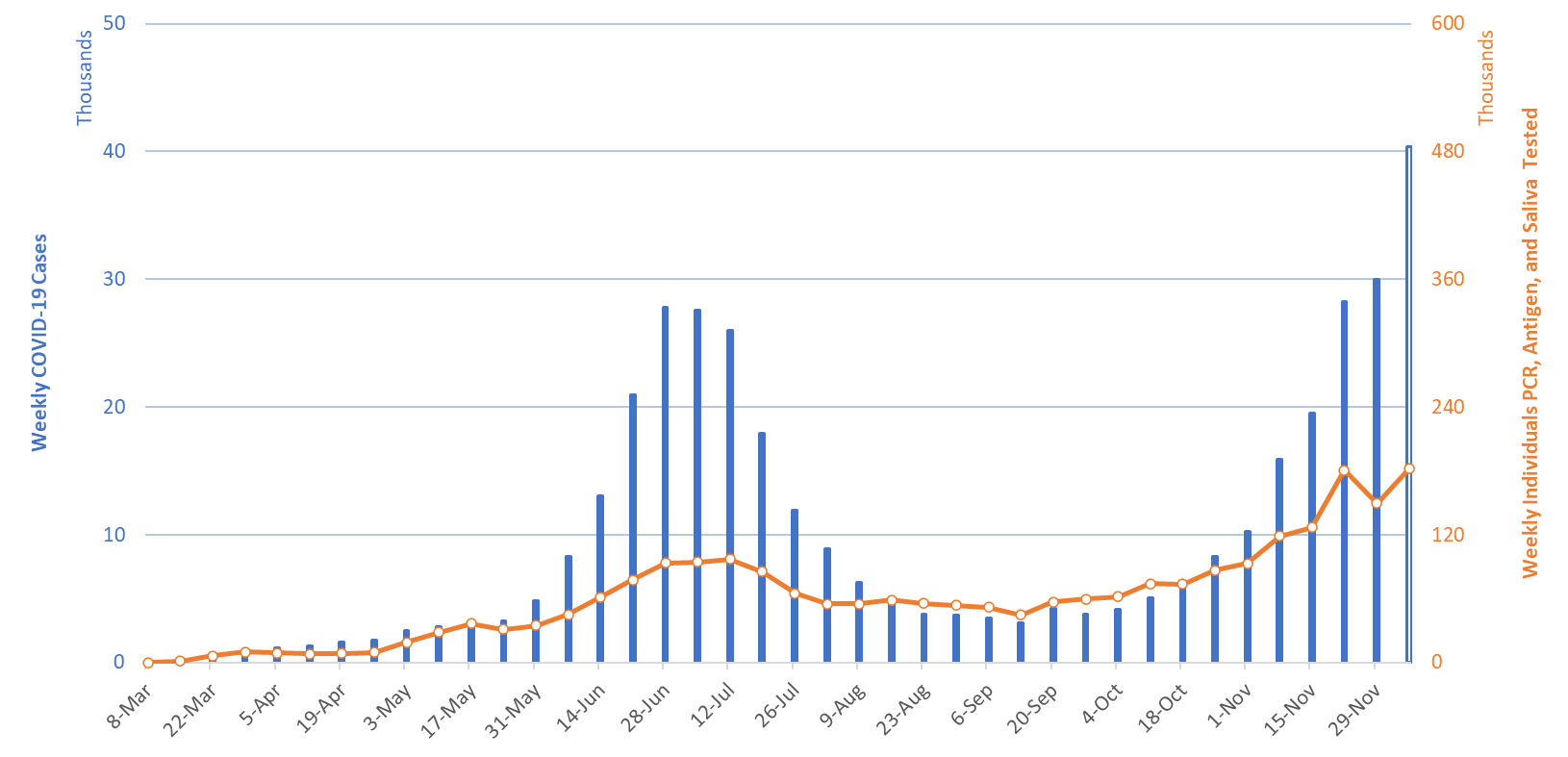
|
Figure 1. Newly Diagnosed Covid-19 Cases in Arizona and Number of Individuals Undergoing Covid-19 Diagnostic Testing March 1 through December 6. |
The outbreak remains broadly entrenched, but transmission among those >64 years of age is concerning given this age group’s higher risk of hospitalization, ICU care, and mortality (Figure 2). Cases rates among those >64 years is now 85% higher than during the June peak, 437 versus 235 weekly cases per 100,000 residents.
Note: Data for this report was updated Friday, December 11 allowing 4 working days to adjudicate weekend cases and keep week-over-week backfill 10%. This allows more interpretable comparisons and graphics. All comparisons are week-over-week changes. Future updates will continue to be released on weekends.
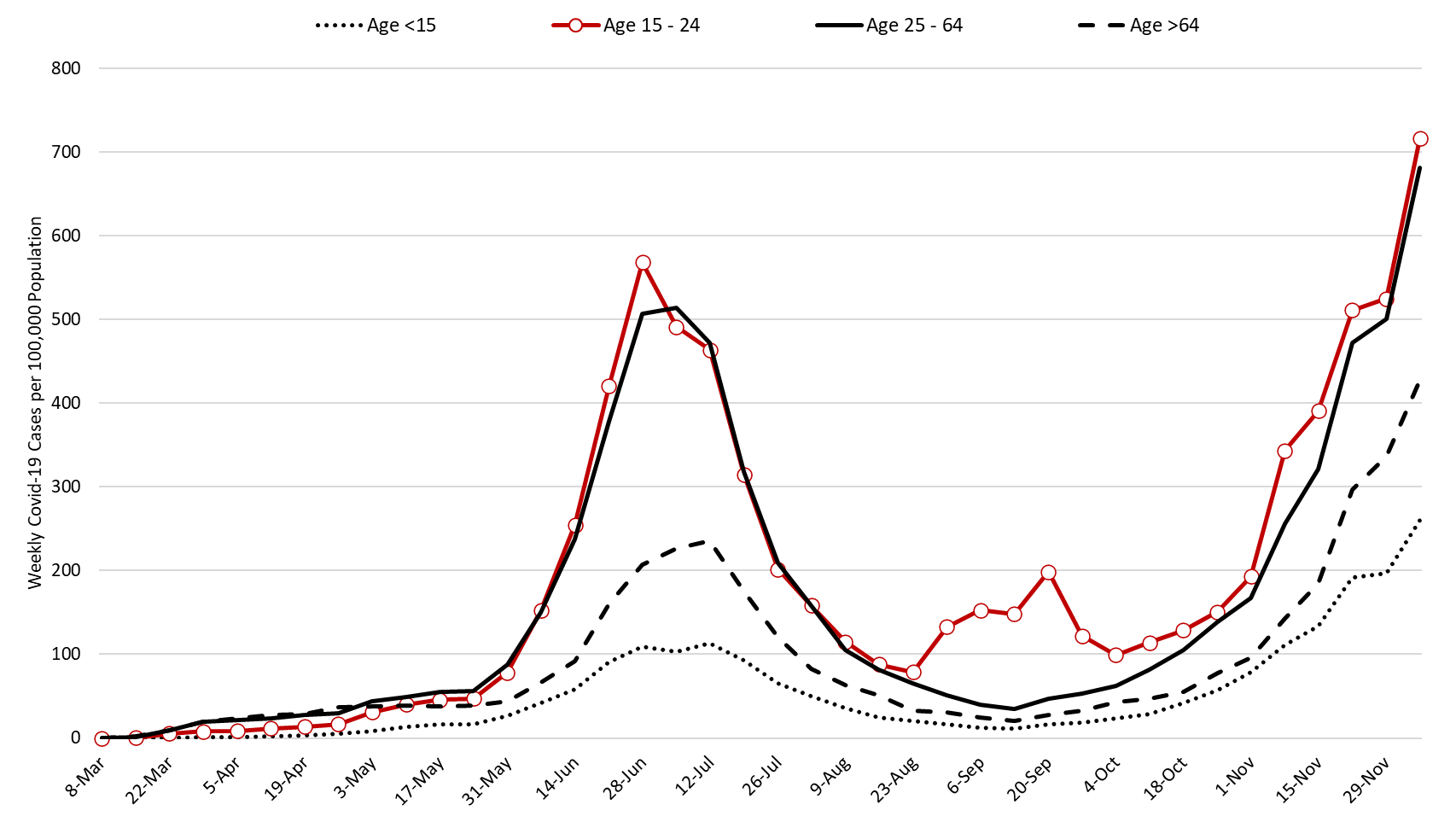
|
Figure 2. Newly Diagnosed Covid-19 Cases in Arizona by Age Group March 1 through December 6. |
Test positivity among those undergoing traditional PCR testing continues to increase, reaching 25.4% this past week (Figure 3). Increasing test positivity indicates that viral transmission continues to increase despite the uncertainty surrounding actual case counts. Test positivity for antigen tests being conducted by the University of Arizona and by some long-term care facilities and retail clinics was 21.1% this week. Test positivity for saliva testing being conducted by Arizona State University for students and other groups was 15.1% this week.
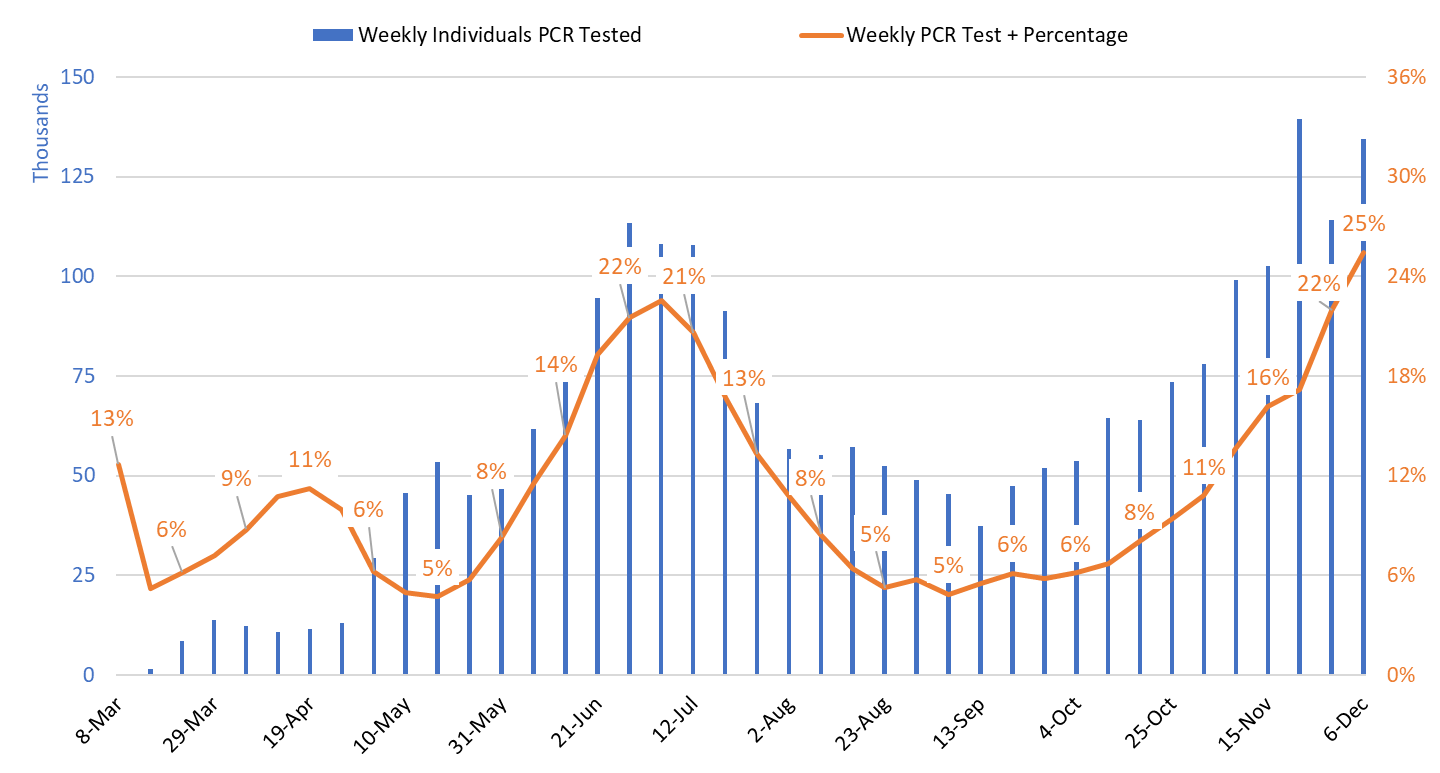
|
Figure 3. Weekly Number Patients PCR Tested and Percent with Positive Test March 1 – December 6. |
As of December 11th, 3534 (41%) of Arizona’s 8621 general ward beds were occupied by Covid-19 patients, a 21% increase from last week’s 2931 occupied beds (Figure 4 and Figure 5 Panel A). Another 768 (9%) beds were available for use. This is lower than the 861 beds available last week.
At 3534 occupied ward beds, Arizona has now exceeded its prior peak of 3517 beds. Because there are more ward beds now, percent occupancy remains below the July 13th peak of 44.7%. However, this record will fall next week.
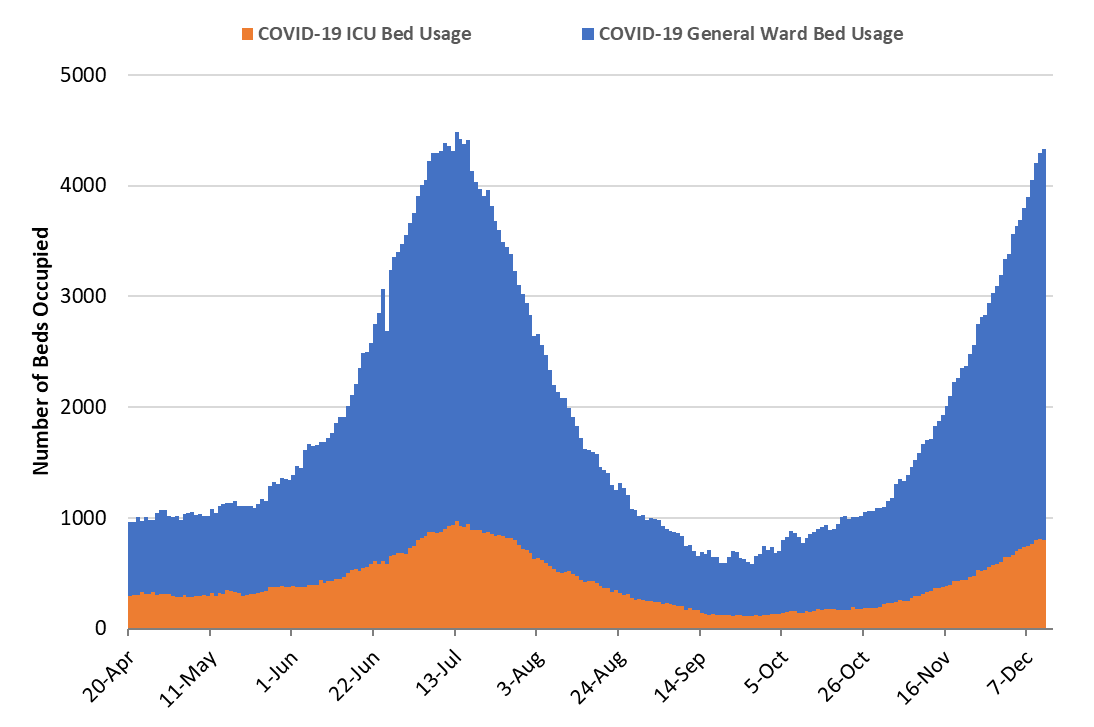
|
Figure 4. Arizona Daily Covid-19 General Ward and ICU Census April 20 – December 11. |
As of December 11th, 799 (45%) of Arizona’s 1760 ICU beds were occupied with Covid-19 patients, a 14% increase from last week’s count of 701 patients (Figure 4 and Figure 5 Panel B). An additional 163 (9%) ICU beds remain available. This is higher than last week’s 144 beds. Max Covid-19 ICU occupancy was 970 beds on July 13th. If weekly increases persist, the previous peak will be reached before Friday, December 25th.
|
Figure 5. Covid-19 Occupancy as a Percent of Listed General Ward (A, left) and ICU (B, right) Capacity in Arizona April 20 – December 11. |
Arizona hospitals’ safety margin continues to erode in both the ward and ICU (Figure 6). Most hospitals have now cancelled scheduled procedures to ensure adequate capacity for patients with Covid-19 care. We are now undergoing the great “displacement” such that hospital services are now being rationed so that patients with severe Covid-19 illness are displacing others who have slightly less severe non-Covid medical conditions. As Covid-19 illness continues to increase, delaying others’ care will become ever more difficult. At some point, hospitals will have to expand their physical capacity. Make no mistake, the Covid-19 crisis is now placing a greater share of Arizonans’ health at-risk, not just those unfortunate enough to contract Covid-19.

|
Figure 6. Observed Excess Non-Surge General Ward and ICU Capacity April 20 – December 11. |
With 617 deaths, the week ending July 19th remains Arizona’s deadliest week (Figure 7). Weekly Covid-19 mortality reached a nadir of 46 deaths the week ending October 4th. Because cases have been increasing, deaths are now increasing. Sharper rises are expected over the coming weeks as deaths lag new cases by 14-days and are often only made known weeks later.
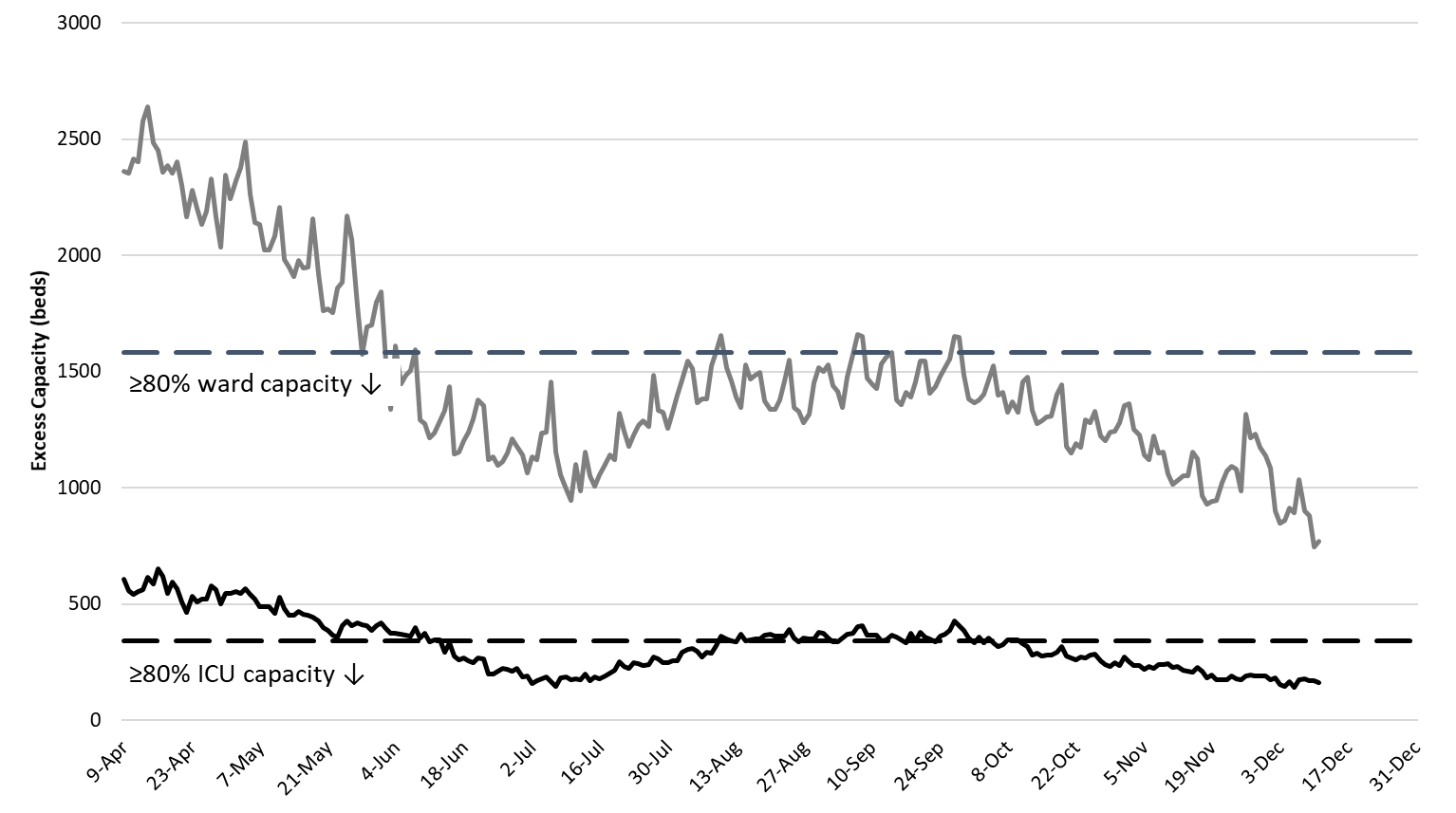
|
Figure 7. Weekly Arizona Covid-19 Deaths March 1 – December 6. |
However, the case fatality rate has held relatively stable at approximately 1.5% (Figure 8). By Christmas, Arizona will be experiencing >500 deaths per week. However, this toll will not be apparent until mid-January when all deaths are accounted for.
It is difficult to say with certainty why the CFR has fallen over time. Clinicians are now much more experienced at managing Covid-related respiratory failure, relying less on mechanical ventilation and more on high flow oxygen therapy and proning. Treatment protocols are likely more standardized with proven beneficial treatments being more consistently applied, and perhaps more importantly, harmful practices discontinued. Better infection control practices at long-term care facilities has also reduced infections among the most medically frail patients who have so far accounted for 40% of Covid-related deaths in Pima County.
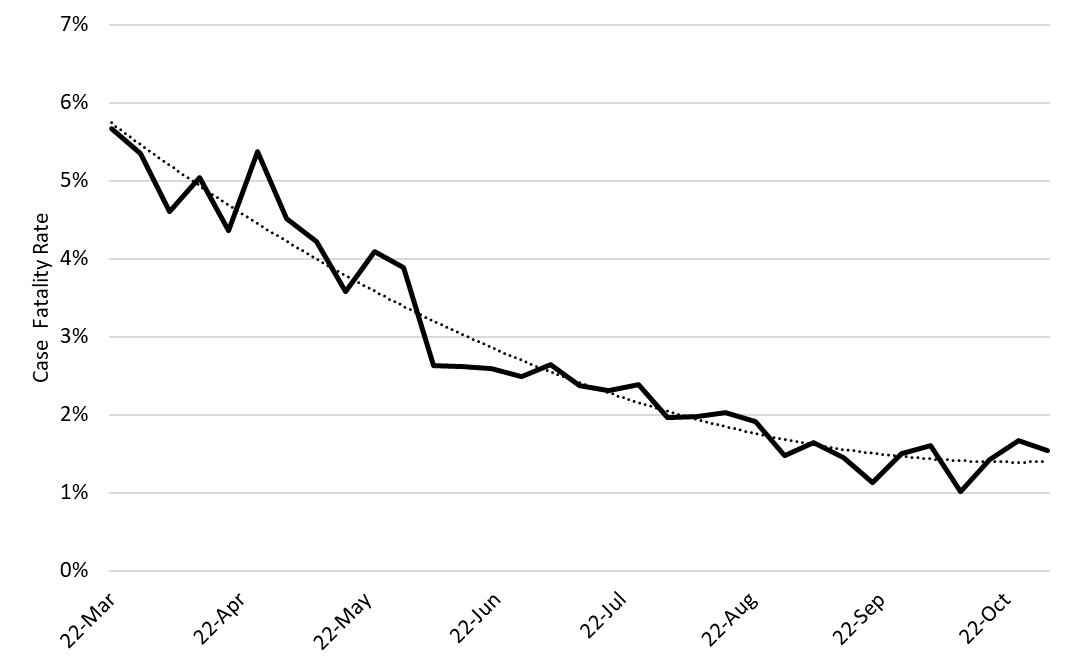
|
Figure 8. Case Fatality Rate March 22 – November 1. Age Distribution Standardized to Week of October 25. |
Winner, Winner, Chicken Dinner
For those keeping score, Arizona has the fastest increasing Covid-19 outbreak as measured by Rt.live. Arizona’s effective viral reproduction number (Rt) is now 1.22, the highest in the nation (Figure 9). However, we are “only” 14th in the number of daily cases at 81.9 per 100,000 residents (CDC). We can move ahead of Delaware, currently holding 13th place at 82.4 per 100,000 residents, if we continue to do nothing. Remember, when it comes to Covid less (mitigation) is more (cases)!
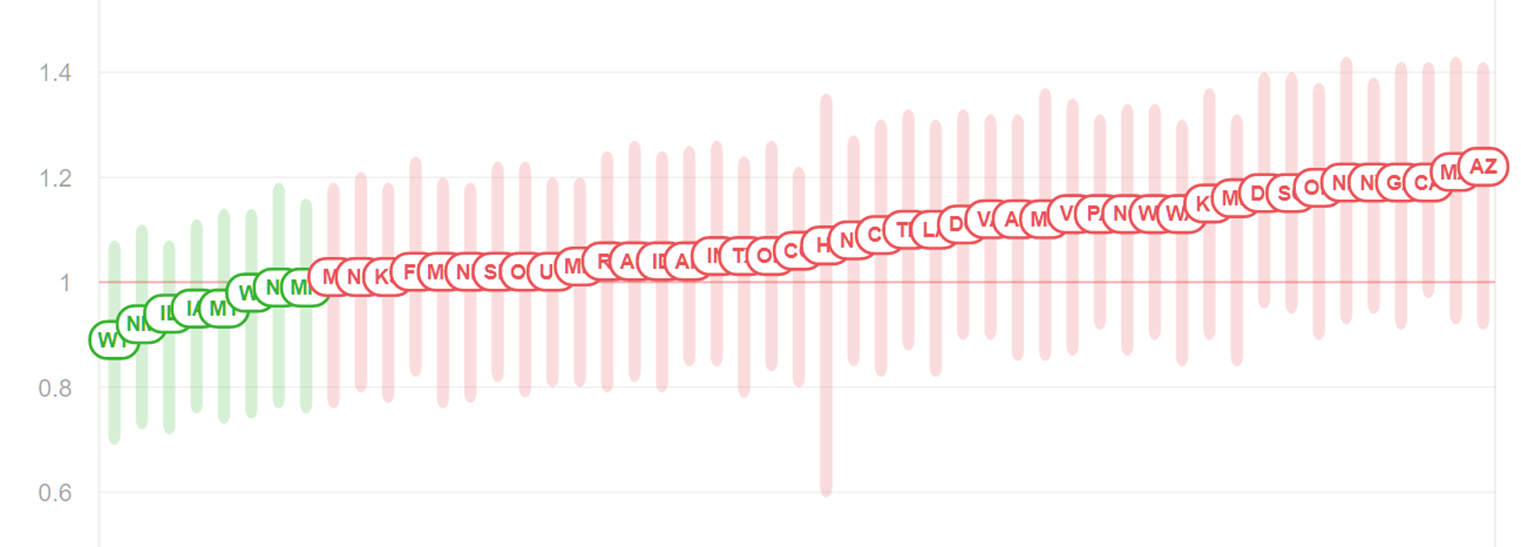
|
Figure 9. State Comparison of Effective Reproduction Number (Rt) from Rt.live November 12, 2020. |
Pima County Outlook
For the week ending December 6th, 6326 Pima County residents were diagnosed with Covid-19 (Figure 10). This represents a 68% increase from the 3762 cases initially reported last week. This tally is far higher than the old record of new record for cases in a single week. Test reporting remains relatively timely with reporting delays causing last week’s initial tally of 3660 cases to be upwardly revised by 4% (144 cases) this week.
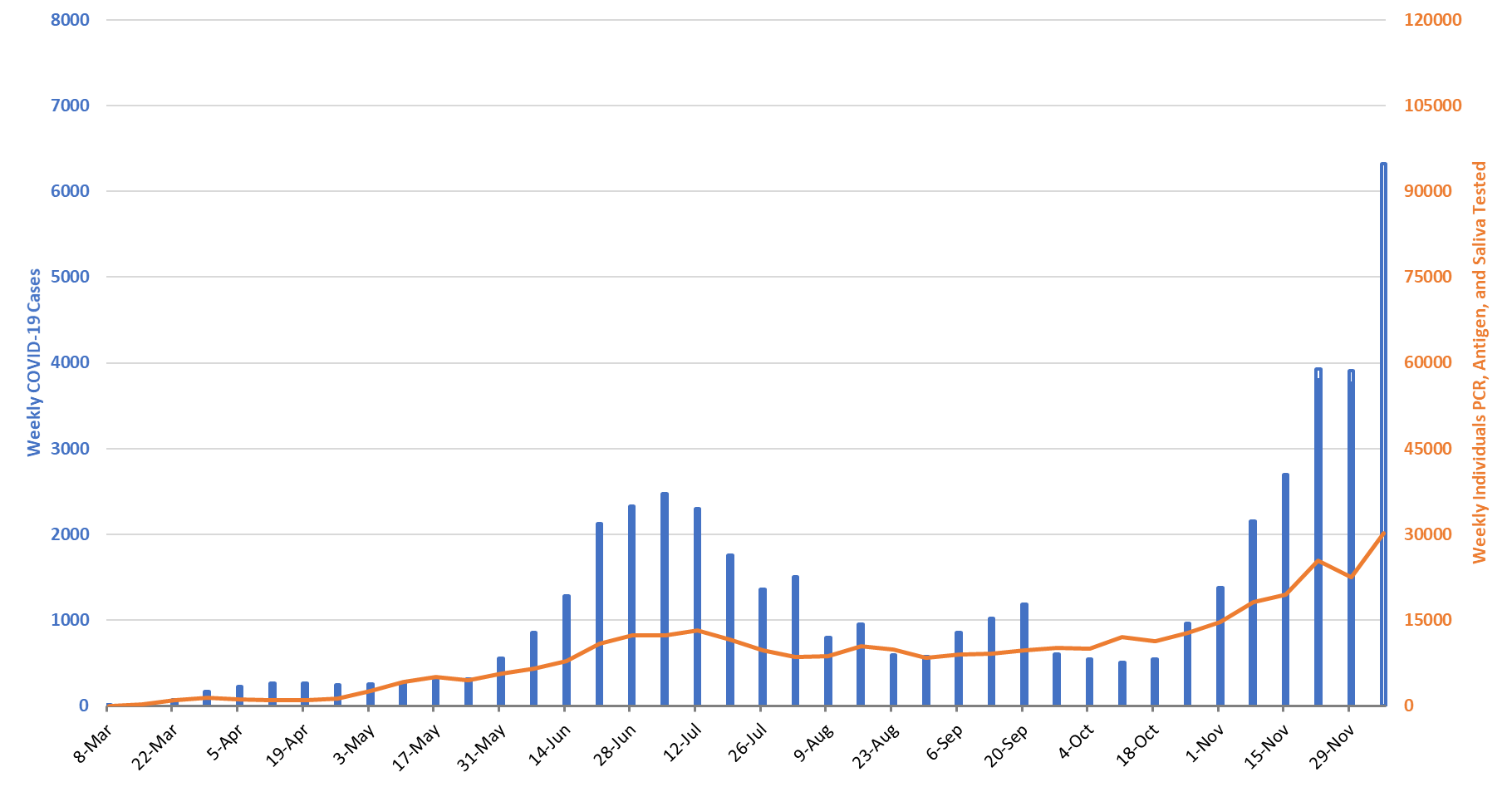
|
Figure 10. Covid-19 Cases and Individuals Undergoing Diagnostic Testing in Pima County Mar 1 – Dec 6. |
Increases in viral transmission are occurring across all age groups (Figure 11).
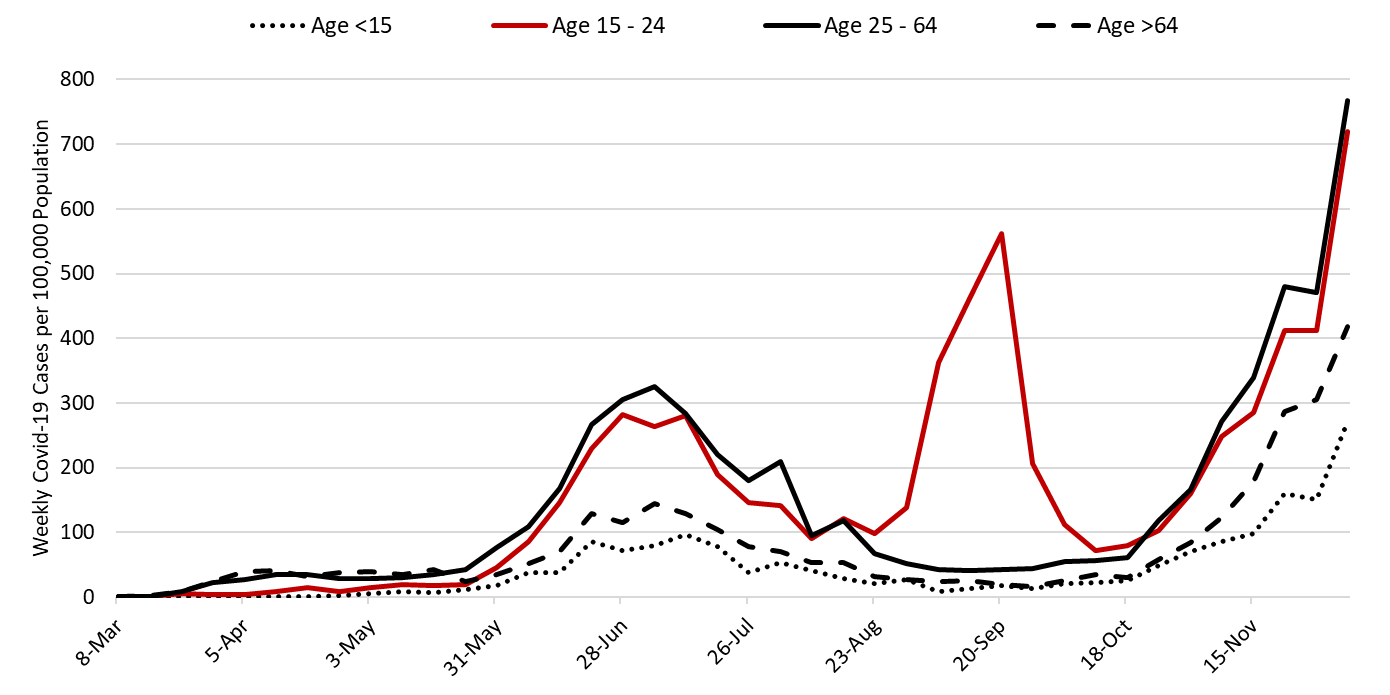
|
Figure 11. Covid-19 Cases by Age Group in Pima County from March 1 – December 6. |
Arizona State University Covid-19 Forecast
There was no update this week to the ASU Covid-19 model of projected cases, hospitalizations, and deaths through mid-January (full report). The current data continue to track as expected (Figure 11). The main findings are summarized in Figure 11. Assuming current viral transmission rates continue unabated, total Covid-19 hospitalizations in Arizona could exceed the total number of hospital beds by early January (green line). This change does not reflect increases that might occur because of Thanksgiving travel and gatherings.
**A special thank you to the members of the ASU Covid-19 Modeling Group for their efforts to bring greater understanding of the current outbreak and for sharing their report. Readers are encouraged to read the full report which can be found here.

|
Figure 11. ASU Covid-19 Modeling Group Estimate of Total Covid-19 Hospitalization in Arizona through January 21st. Produced by Esma Gel, PhD, Megan Jehn, PhD, Anna Muldoon MPH, Health Ross, PhD, DNP, ANP-BC, and Tim Lant, PhD, MAS (November 24 Update). |
Summary
- Viral transmission is increasing throughout Arizona. New Covid-19 cases will overwhelm our capacity to provide hospital care by the first of January.
- New cases are being diagnosed at a rate of at least 567 cases per 100,000 residents per week. This rate is increasing by approximately 179 cases per 100,000 residents per week.
- We have now all but locked in a major humanitarian crisis during the Christmas – New Year holiday with hundreds of preventable deaths per week.
- Holiday travel, commerce, and social gatherings between Thanksgiving and New Years are likely to accelerate transmission rates without additional public health interventions.
- A state-wide shelter-in-place order is warranted to slow transmission and to mitigate the worst of overcrowding in our hospital system. A state-wide mask mandate is also needed. Individuals and business who do not comply with restrictions should face sanctions.
- If such actions are taken, they must be accompanied by additional state funds to alleviate food insecurity, to prevent evictions and foreclosures, and to protect access to health services as the loss of economic support from the CARES Act is a likely contributor to increased transmission.
- Acknowledging that a shelter-in-place order is unlikely, counties should be granted additional authority to establish and enforce alternative Covid-19 mitigation policies.
- All Arizona residents should wear a mask in public, avoid social gatherings, maintain physical distance from non-household contacts, avoid >15 minutes contact in indoor spaces, especially if physical distancing is inadequate and adherence to face masks is low.
- Hospital Covid-19 occupancy has now exceeded the previous peak number of hospitalized patients and ICUs will set new records by the end of next week. By early January hospital capacity will be overwhelmed by new Covid-19 cases
- Hospitals are already postponing scheduled procedures; essentially additional capacity is being created at the expense of others with serious non-Covid medical conditions. However, this coping mechanism will be exhausted by the end of the month.
- Health professionals are being asked to work additional hours and assume new duties. Shortages and burn-out will degrade our capacity to provide critical care services over the coming weeks.
- The test positive rate for traditional PCR testing reached 25% this week. The growing mismatch between testing capacity and demand indicates viral transmission is growing faster than estimated here.
- Covid-19 mortality continues to increase. While case fatality rates remain lower than those observed with this summer’s outbreak, deaths are rising quickly. Arizona will record >500 Covid-19 deaths per week by Christmas.
Forecast reports to date, available as PDFs
Download PDF to view additional charts of Arizona counties, available in appendix of report.
Based on what we know now about this pandemic, we support guidelines for social distancing to slow the spread of the virus and urge everyone to follow the recommendations provided by the Centers for Disease Control and Prevention (CDC) to protect yourself, your family, your neighbors, and your employees. Please heed the recommendations as provided by the CDC, found at the following website: https://www.cdc.gov/coronavirus/2019-ncov/prepare/prevention.html
COVID covid coronavirus virus covid19 corona forecast model

